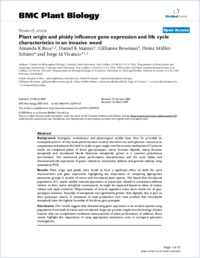Plant origin and ploidy influence gene expression and life cycle characteristics in an invasive weed
- Broz, Amanda K. Center for Rhizosphere Biology, Colorado State University, Fort Collins, USA - Department of Horticulture and Landscape Architecture, Colorado State University, Fort Collins, USA
- Manter, Daniel K. USDA-ARS, Soil-Plant-Nutrient Research Unit, Fort Collins, USA
- Bowman, Gillianne Département de Biologie/Ecologie & Evolution, Université de Fribourg Switzerland
- Müller-Schärer, Heinz Département de Biologie/Ecologie & Evolution, Université de Fribourg Switzerland
- Vivanco, Jorge M. Center for Rhizosphere Biology, Colorado State University, Fort Collins, USA - Department of Horticulture and Landscape Architecture, Colorado State University, Fort Collins, USA
-
23.03.2009
Published in:
- BMC Plant Biology. - 2009, vol. 9, p. 33
English
Background: Ecological, evolutionary and physiological studies have thus far provided an incomplete picture of why some plants become invasive; therefore we used genomic resources to complement and advance this field. In order to gain insight into the invasive mechanism of Centaurea stoebe we compared plants of three geo-cytotypes, native Eurasian diploids, native Eurasian tetraploids and introduced North American tetraploids, grown in a common greenhouse environment. We monitored plant performance characteristics and life cycle habits and characterized the expression of genes related to constitutive defense and genome stability using quantitative PCR. Results: Plant origin and ploidy were found to have a significant effect on both life cycle characteristics and gene expression, highlighting the importance of comparing appropriate taxonomic groups in studies of native and introduced plant species. We found that introduced populations of C. stoebe exhibit reduced expression of transcripts related to constitutive defense relative to their native tetraploid counterparts, as might be expected based on ideas of enemy release and rapid evolution. Measurements of several vegetative traits were similar for all geo-cytotypes; however, fecundity of tetraploids was significantly greater than diploids, due in part to their polycarpic nature. A simulation of seed production over time predicts that introduced tetraploids have the highest fecundity of the three geo-cytotypes. Conclusion: Our results suggest that characterizing gene expression in an invasive species using populations from both its native and introduced range can provide insight into the biology of plant invasion that can complement traditional measurements of plant performance. In addition, these results highlight the importance of using appropriate taxonomic units in ecological genomics investigations.
- Faculty
- Faculté des sciences et de médecine
- Department
- Département de Biologie
- Language
-
- English
- Classification
- Biological sciences
- License
-
License undefined
- Identifiers
-
- RERO DOC 12215
- DOI 10.1186/1471-2229-9-33
- Persistent URL
- https://folia.unifr.ch/unifr/documents/301130
Statistics
Document views: 117
File downloads:
- pdf: 133
